
Broken Bow is a city in McCurtain County, Oklahoma, United States. The population was 4,120 at the 2010 census. It is named after Broken Bow, Nebraska, the former hometown of the city's founders, the Dierks brothers. Other Dierks-associated legacies in town include Dierks Elementary School, Dierks Street, and Dierks Train #227 which is preserved in Broken Bow.
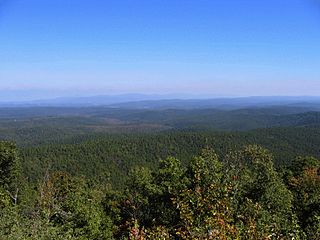
The Ouachita National Forest is a vast congressionally-designated National Forest that lies in the western portion of Arkansas and portions of extreme-eastern Oklahoma, USA.

The Ouachita Mountains, simply referred to as the Ouachitas, are a mountain range in western Arkansas and southeastern Oklahoma. They are formed by a thick succession of highly deformed Paleozoic strata constituting the Ouachita Fold and Thrust Belt, one of the important orogenic belts of North America. The Ouachitas continue in the subsurface to the northeast, where they make a poorly understood connection with the Appalachians and to the southwest, where they join with the Marathon uplift area of West Texas. Together with the Ozark Plateaus, the Ouachitas form the U.S. Interior Highlands. The highest natural point is Mount Magazine at 2,753 feet (839 m).

Amorpha is a genus of plants in the pea family, Fabaceae. All the species are native to North America, from southern Canada, most of the United States (US), and northern Mexico. They are commonly known as false indigo. The name Amorpha means "deformed" or "without form" in Greek and was given because flowers of this genus only have one petal, unlike the usual "pea-shaped" flowers of the Faboideae subfamily. Amorpha is missing the wing and keel petals.

Graptemys is a genus of freshwater turtles containing 14 species, commonly known as map turtles. Graptemys are small to medium-sized turtles that are significantly sexually dimorphic, with females in some species attaining as much as twice the length and ten times the mass as males. Depending on the species, adult males range from 7–16 cm (2.75–6.25 in), adult females 10–29.5 cm (4–11.62 in), and hatchlings 2.5–3.8 cm (1–1.5 in), although some sources indicate female Barbour's map turtles grow to 33 cm (13 in) in length. Most species have a distinctive dark pigmented keel that is often notched or serrated running down the center of the carapace and serrated scutes on the rear margin. The head, neck, and limbs exhibit bold patterns of yellow lines and spots against darker green, olive, or black base colors. The patterns on the head can be important characters in identifying the various species. The common name "map turtle" is derived from the intricate patterns on their shells that are suggestive of topographical maps, although the patterns are more apparent in some species than others, and often become obscure in older specimens. Some species are occasionally called "sawbacks", in reference to the serrated keels on their shell.

Amsonia hubrichtii, commonly known as Hubricht's bluestar, Arkansas bluestar, or thread-leaf bluestar, is a North American species of perennial flowering plant in the Apocynaceae (dogbane) family, first described in 1943. It is native to Oklahoma and Arkansas in the south-central United States. It is commonly used as an ornamental plant.
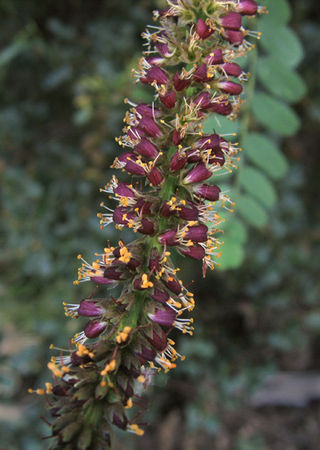
Amorpha californica is a species of flowering plant in the legume family known by the common name California false indigo.
The Ouachita shiner or Ouachita Mountain shiner is a species of ray-finned fish in the family Cyprinidae. It is found only in the upper Little River system in the Ouachita Mountains of Arkansas and Oklahoma in the United States.

The Ouachita dusky salamander is a species of salamander in the family Plethodontidae. It is endemic to the states of Arkansas and Oklahoma in the United States. The specific epithet is in honor of Herbert Hutchinson Brimley and his younger brother, Clement Samuel Brimley, both of whom were zoologists.
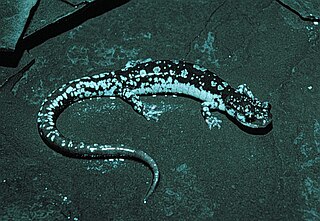
The Fourche Mountain salamander is a species of salamander in the family Plethodontidae endemic to the Ouachita Mountains in the central United States. Its natural habitat is temperate forests and it is threatened by habitat loss.

The Rich Mountain salamander is a species of salamander in the family Plethodontidae. It is endemic to the Ouachita Mountains in western Arkansas and eastern Oklahoma. Its natural habitat is temperate forests. It is threatened by habitat loss.
The longnose darter is a species of freshwater ray-finned fish, a darter from the subfamily Etheostomatinae, part of the family Percidae, which also contains the perches, ruffes and pikeperches. It is endemic to the United States.

Arcidens wheeleri is a species of freshwater mussels in the family Unionidae, the river mussels. Its common names are the Ouachita rock pocketbook and Wheeler's pearly mussel. The former monotypic genus of Arkansia was named for the state of Arkansas, where the mussel was first discovered.
Rich Mountain slitmouth or Pilsbry's narrow-apertured land snail, scientific name Stenotrema pilsbryi, is a species of air-breathing land snail, a terrestrial pulmonate gastropod mollusk in the family Polygyridae. This species is endemic to Ouachita Mountains of the United States.
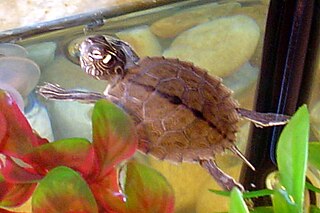
The Ouachita map turtle is a species of turtle belonging to the family Emydidae.
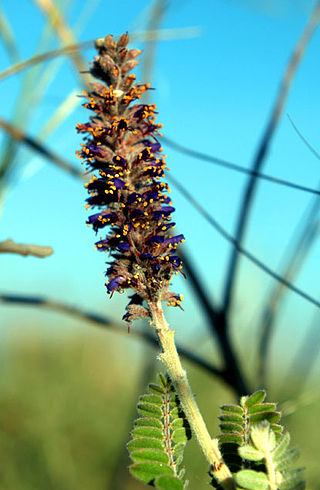
Amorpha canescens, known as leadplant, downy indigo bush, prairie shoestring, or buffalo bellows, is a small, perennial semi-shrub in the pea family (Fabaceae), native to North America. It has very small purple flowers with yellow stamens which are grouped in racemes. Depending on location, the flowers bloom from late June through mid-September. The compound leaves of this plant appear leaden due to their dense hairiness. The roots can grow up to 5 m (16 ft) deep and can spread up to 1 metre radially. This plant can be found growing in well-drained soils of prairies, bluffs, and open woodlands.
Procambarus liberorum is a species of crayfish in the family Cambaridae. It is endemic to the United States, where it occurs in Arkansas and Oklahoma. It is known commonly as the Osage burrowing crayfish.

Ilex ambigua is a species of flowering plant in the holly family known by the common names Carolina holly and sand holly. It is native to the southeastern and south-central United States, along the coastal plain from North Carolina to Texas, inland as far as Oklahoma, Arkansas, and Tennessee.

Solidago ouachitensis is a North American species of flowering plants in the family Asteraceae known by the common name Ouachita Mountain goldenrod. It has a very limited range, found only in the Ouachita Mountains along the border between Arkansas and Oklahoma in the United States.
















